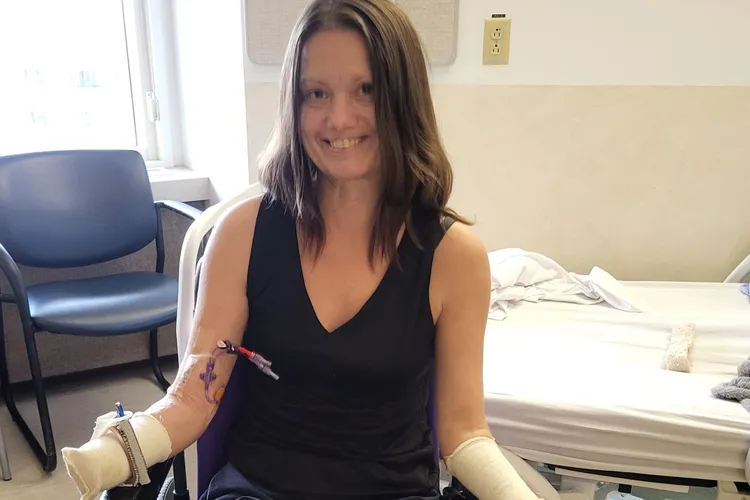She Went to the Hospital with Jaw Pain — Days Later She Lost All Four Limbs to a Hidden ‘Silent Killer’ Doctors Warn Could Strike Anyone
Jane Haley still remembers the exact moment her life changed forever, even though much of the ordeal unfolded while she was unconscious. One day she was a healthy, active woman battling what she believed was the tail end of an ordinary case of strep throat. The next, she was fighting for her life in a hospital bed, hooked to machines that were working around the clock to stabilize her failing body. What began with mild jaw and neck pain spiraled into a medical emergency so severe that doctors were forced to remove all four of her limbs to keep her alive. It is a journey that she never imagined would be hers, and a warning she hopes can save others from the same fate.

In the time since her medical crisis, Jane has spoken often about how deceptively normal the beginning of her illness felt. After recovering from strep throat earlier that month, she still felt lingering tension in her jaw, along with general fatigue — symptoms that many people might chalk up to stress, dental strain, or the aftermath of a routine infection. She still went to work, still tried to power through, still told herself she would feel better once she rested. Instead, her pain worsened, and her body began to shut down in ways she could not see. By the time she finally sought medical help, her condition had become serious enough that doctors immediately admitted her and began a rapid evaluation to determine the source of her distress.
Within hours, her medical team uncovered the devastating truth: Jane’s earlier case of strep throat had progressed into a severe, fast-moving Group A Streptococcus infection. While Group A strep is typically known for causing minor illnesses, it can, in extremely rare cases, trigger an aggressive, life-threatening reaction known as streptococcal toxic shock syndrome. This condition can overwhelm the body quickly, causing a cascade of internal failures that demand immediate intervention. For Jane, the diagnosis came just in time — she had already begun experiencing organ stress, dangerously low blood pressure, and signs of tissue damage.
Doctors placed her into a medically induced coma to give her body the best chance of recovering without further shock. She remained unconscious as experts worked tirelessly to stabilize her organs, control her infection, and prevent additional complications. Family members kept vigil by her bedside, speaking softly into a room filled with machines, alarms, and monitors, hoping she could somehow hear their voices over the constant medical activity. It was a nightmare none of them had anticipated, and one no one knew how it would end.

When Jane finally woke up days later, she was disoriented, weak, and surrounded by medical staff who knew they had to deliver news that would alter her life. As her infection progressed, it had caused severe circulation issues, leading to widespread tissue death in her extremities — a known but devastating consequence of toxic shock syndrome. Her hands and feet had suffered irreversible damage. To save her life, surgeons would need to amputate all four limbs.
Hearing the diagnosis, even in her foggy state, was overwhelming. Jane remembers trying to make sense of their words, trying to understand how her world had shifted so suddenly, and trying to grasp the reality of what the next chapter would look like. But in that terrifying moment, she also felt an unexpected clarity. She wanted to live. She wanted to survive, no matter what it required. And with that resolve, she agreed to the operations that would remove the dying tissue and give her a chance at life.
The surgeries were long, complex, and difficult — both for Jane and for the medical teams who had grown invested in her case. When she awoke afterward, she faced a profoundly altered future. Gone were the hands she once used to cook, drive, type, and hug. Gone were the feet that once carried her on long walks, across grocery store floors, and through everyday life. What remained was a woman who had survived something extraordinary — and who now needed to learn how to rebuild from the ground up.
Rehabilitation began almost immediately. Jane was placed in specialty care facilities that support amputees through their earliest recovery stages. Physical therapists taught her how to strengthen her core, maintain balance, and prepare for future prosthetic fittings. Occupational therapists helped her relearn how to perform daily tasks using modified techniques and assistive devices. Nurses, counselors, and volunteers surrounded her with practical support and emotional encouragement, reminding her daily that her life was not defined by what she had lost, but by what she still had to fight for.
Throughout her hospital stay, Jane met other survivors of severe infections, amputations, and traumatic medical events. The community gave her strength during the moments she felt mentally exhausted or discouraged. She recalls breaking down more than once, overwhelmed not just by physical pain, but by the grief of losing her independence. Each time, someone — a nurse, a therapist, a fellow patient — sat with her and reminded her that healing was not a sprint. That acceptance would take time. That hope could coexist with sadness.

Slowly, Jane began to reclaim pieces of her identity. She learned how to sit up on her own, how to maneuver in a wheelchair, how to feed herself with adaptive tools, and eventually, how to smile again. Her care team celebrated every milestone, no matter how small, because they understood how monumental each victory was in the context of her recovery. Every day brought a new challenge, but also a new chance for progress.
Speaking about her experience now, Jane calls herself grateful — not because the ordeal was easy, but because she knows she could have died before doctors ever figured out what was wrong. She praises her medical team for acting quickly, for explaining every step with compassion, and for never letting her feel alone in the darkest moments. She acknowledges the emotional toll the journey has taken, but she continues to emphasize that she is alive — and that life, even in its hardest form, is worth fighting for.
Jane also hopes her story raises awareness about how quickly an infection can escalate. Group A Streptococcus is common, often harmless, and almost always treatable. But in rare cases, like hers, it can transform into a medical emergency without warning. Symptoms like severe fatigue, intense localized pain, dizziness, rapid breathing, unusually low blood pressure, or skin discoloration should never be ignored, especially after recent illness. Jane encourages anyone experiencing strange or worsening symptoms to seek medical help immediately — no matter how small or embarrassing the concern may feel. “If it could happen to me,” she says, “it could happen to anyone.”
As she looks toward the future, Jane is already preparing for the next phase: prosthetics, rebuilding routines, returning to hobbies she loves, and advocating for others experiencing life-altering medical trauma. She has become a symbol of resilience among her care team and her community, not because the path ahead will be easy, but because she refuses to give up on the extraordinary life she still has the opportunity to live.
Her journey is far from over, but each day she writes a new chapter — one built on strength, survival, gratitude, and courage.



